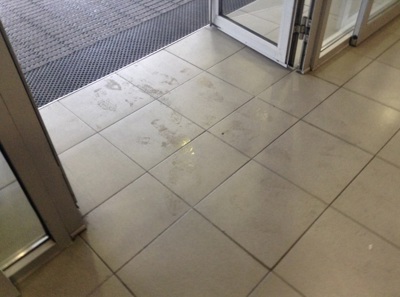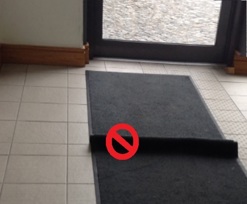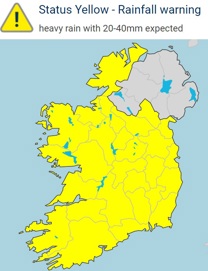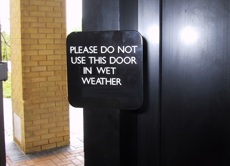Entrances Safeguards to Control Slips, Trips and Falls
- Many entrance slips, trips and falls occur from 8am to 10am
- Step(s), wet surfaces, ice/(snow), mats and flooring are factors
- The safest approach may be to ensure the floor areas inside and outside the entrance are slip-resistant when wet
- Wet footprints inside an entrance indicate that moisture is entering the building
Entrance slips can be an important part of Slip Risk Assessment and Prevention
Wet Weather Protocol to Prevent Slips
Monitor for rain/snow and relevant weather warnings such as Met Éireann. Some weather Apps have automatic weather warnings, e.g. “90% chance of rain in the next 15 minutes ”
In wet weather, a wet weather protocol may be required
- Provide a clearly marked designated safe walkway
- Deal with moisture from wet clothes, umbrellas, etc. (Some workplaces provide umbrella stands or umbrella bags)
- Ensure adequate floor mats safely fitted
- Use additional floor mats, properly placed and secured, and replaced as required
- Ensure mats remove moisture from footwear and tyres of baby carriages, shopping trollies, wheelchairs
- Check for wet footprints or tyre tracks beyond floor matting. Increase monitoring for wet floors by clearly nominated persons

- Rapid removal of spills by a clearly nominated person
- Provide spill kits and floor drying equipment, e.g. squeegee vacuums
- Remember that safety signs do not substitute for necessary protective measures
- Consider additional precautions for peak times, e.g. 8am to 10am
Wet Weather Protocol - Pedestrian Channels
Consider creating clear safe pedestrian channels at larger slippery entrances, as necessary, including
- Consider closing some entrance points to limit access (must not restrict emergency egress)
- Use barriers/ cordons to define safe access routes (must not restrict emergency egress)
- Use additional floor mats, properly placed and secured, and replaced as required
- Use signs to direct pedestrians to safe access routes (Signs should only be used where hazards cannot be avoided and must be removed when they no longer apply (2.2 of Part B of Schedule 9)
Structural Precautions to Prevent Slips
- Increase lighting to increase visibility of spills, especially around entrances
- Provide heating - to assist floor or mat drying
- Canopies and lobbies at external entrances may help
- Level changes and steps/stairs at entrances can pose additional risks
- Properly sited drainage channels may help reduce water ingress

Foot-baths
Foot-baths that introduce liquid to feet or shoes may increase the risk of slipping
- Carefully consider the actual risk of transfer of infection from shoes/ feet if considering foot-baths
- Only use foot-baths following a thorough risk assessment with additional safeguards as required
Entrance Matting
Entrance mats can pose their own hazards and controls must be put in place

Location of Entrance Matting
- Extension – matting should extend into the building far enough so that it comes into contact with wheels and footwear for long enough to remove any moisture or soiling. Visual checks can be carried out for wet footprints or tyre tracks after the matting to assess if it is successful
- Commencement – the mat should be the first surface that is contacted when entering a building – it should start immediately at the threshold
- Barrier – matting should be located that it forms a barrier between outside and inside that pedestrians must pass over
- Height – matting should be recessed where necessary to remove any trip hazard
- Security – matting should be secured in place
- Drainage – drainage should be provided as needed, e.g. a drain prior to the mat to reduce any moisture blown into the building
- Location – the mat must be on the route that people actually use - not the route(s) that they are supposed to use
Physical Properties of Entrance Matting

- Abrasion - mats should be abrasive enough to physically remove moisture or other material but not so abrasive that they could catch the soles of footwear. “Limited research suggests that natural fibre materials are the most effective (at removing water from shoes), but further work is required.” Safer surfaces to walk on (CIRIA C652) (254 pages, 22MB pdf). In terms of likely contamination, consider the need for wiping and/or scraping of the soles of footwear
- Absorption - mats should be absorbent enough to soak-up and retain the moisture they will be exposed to. Consider how to dry and/or drain mats
- Dryability – mats should dry as quickly as possible
- Flat - scrapers/strips included in matting should not be so high that they prevent traffic contacting the absorbent material
- Durability – the mat should be reasonably durable and be capable of dealing with expected pedestrian traffic including heels and wheels. Mats should be resistant to mould, fungus and bacteria
- Density - soft matting can be difficult in a wheelchair as it compresses. It can also be a trip hazard to others using walking sticks or frames
- Colour – visual contrast should be considered
- Signage – many mats can be printed with specific messages. Consider the possibility of using mats to relay important safety information
- Cleanability – mats should be capable of being kept reasonably clean using equipment that’s readily available
- Scrapers – if an entrance matting system incorporates scrapers/ scraping strips, such as aluminium or plastic, consider if this suggested scraping effect is required for the expected footwear soiling
- Edging – where entrance matting is not recessed into a mat-well, ensure that the edging does not provide a trip hazard. Edging may be bevelled (for access of wheeled traffic), weighted (to prevent lifting) and brightly coloured (to act as a visual prompt)
- Slip-resistance – mats should be slip-resistant when wet


